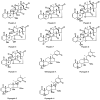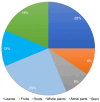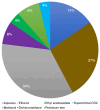Physalis angulata Linn. as a medicinal plant (Review)
- PMID: 38357237
- PMCID: PMC10865294
- DOI: 10.3892/br.2024.1735
Physalis angulata Linn. as a medicinal plant (Review)
Abstract
There are numerous medicinal benefits from herbal plants, with many herbal medicines being used as 'Jamu', 'standardized herbal medicines' and phytopharmaceuticals. Physalis angulata Linn. (P. angulata L.), a plant utilized for both medicinal and food consumption purposes in a number of tropical and subtropical nations, is widely studied for its beneficial properties. The present review summarized the scientific evidence which suggested that P. angulata L. possesses antibacterial, anticancer, antiparasitic, anti-inflammatory, antifibrotic and antidiabetic properties. Furthermore, the various pharmacological studies that have been conducted utilizing in vivo and in vitro models, as well as the identification of phytochemical components with therapeutic value are described. In addition, the present review explained the solvents and the toxicity tests that were used for the investigation of P. angulata L. The authors aspire that this literature review will provide an overview for researchers regarding the scientific progress of P. angulata L. over the past ten years and the potential areas of future research.
Keywords: Physalis angulata Linn; extraction; in vitro; in vivo; medicinal uses; phytochemical.
Copyright: © Novitasari et al.
Conflict of interest statement
The authors declare that they have no competing interests.
Figures





Similar articles
-
Antioxidant, Antiinflammation, and Antifibrotic Activity of Ciplukan (Physalis angulata L). Extract.J Inflamm Res. 2024 Sep 10;17:6297-6306. doi: 10.2147/JIR.S470318. eCollection 2024. J Inflamm Res. 2024. PMID: 39281772 Free PMC article.
-
A new squalene derivative from Physalis angulata L. (Solanaceae).Nat Prod Res. 2022 Apr;36(8):2154-2157. doi: 10.1080/14786419.2020.1844691. Epub 2020 Nov 23. Nat Prod Res. 2022. PMID: 33222550
-
Transcriptome-wide identification of microRNAs and functional insights inferred from microRNA-target pairs in Physalis angulata L.Plant Signal Behav. 2019;14(8):1629267. doi: 10.1080/15592324.2019.1629267. Epub 2019 Jun 11. Plant Signal Behav. 2019. PMID: 31184247 Free PMC article.
-
Physalis alkekengi L. var. franchetii (Mast.) Makino: An ethnomedical, phytochemical and pharmacological review.J Ethnopharmacol. 2018 Jan 10;210:260-274. doi: 10.1016/j.jep.2017.08.022. Epub 2017 Aug 31. J Ethnopharmacol. 2018. PMID: 28838654 Review.
-
Withanolides from the genus Physalis: a review on their phytochemical and pharmacological aspects.J Pharm Pharmacol. 2020 May;72(5):649-669. doi: 10.1111/jphp.13209. Epub 2019 Dec 11. J Pharm Pharmacol. 2020. PMID: 31826333 Review.
Cited by
-
Antioxidant, Antiinflammation, and Antifibrotic Activity of Ciplukan (Physalis angulata L). Extract.J Inflamm Res. 2024 Sep 10;17:6297-6306. doi: 10.2147/JIR.S470318. eCollection 2024. J Inflamm Res. 2024. PMID: 39281772 Free PMC article.
-
The chemopreventive effects of native Brazilian plants on stomach cancer: A review of the last 25 years.Oncoscience. 2025 May 8;12:36-51. doi: 10.18632/oncoscience.618. eCollection 2025. Oncoscience. 2025. PMID: 40343252 Free PMC article. Review.
-
Antidiabetic Potential of Combined Cassiavera and Morel Berry Ethanol Extracts in Diabetic Rats.ScientificWorldJournal. 2025 May 20;2025:1526410. doi: 10.1155/tswj/1526410. eCollection 2025. ScientificWorldJournal. 2025. PMID: 40433165 Free PMC article.
References
-
- Mahklouf MH. The first record of Physalis angulata L. (Solanaceae) for the flora of Libya. Biodiv Res Conserv. 2019;53:67–71.
-
- Ramakrishna Pillai J, Wali AF, Menezes GA, Rehman MU, Wani TA, Arafah A, Zargar S, Mir TM. Chemical composition analysis, cytotoxic, antimicrobial and antioxidant activities of Physalis angulata L.: A comparative study of leaves and fruit. Molecules. 2022;27(1480) doi: 10.3390/molecules27051480. - DOI - PMC - PubMed
-
- Gao CY, Ma T, Luo J, Kong LY. Three new cytotoxic withanolides from the Chinese folk medicine Physalis angulata. Nat Prod Commun. 2015;10:2059–2062. - PubMed
-
- Hadiyanti N, Supriyadi S, Pardono P. Keragaman beberapa tumbuhan ciplukan (Physalis spp.) di lereng gunung kelud, jawa timur. Berita Biologi. 2018;17:135–146.
Publication types
LinkOut - more resources
Full Text Sources
Miscellaneous
